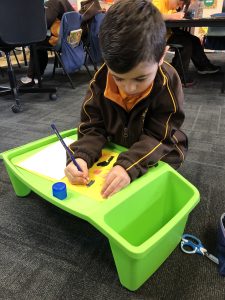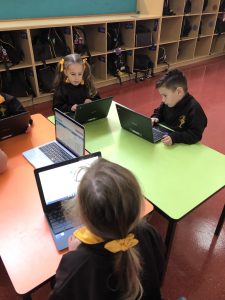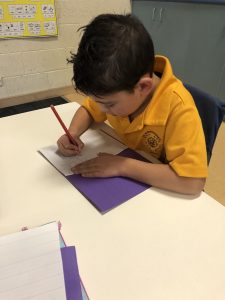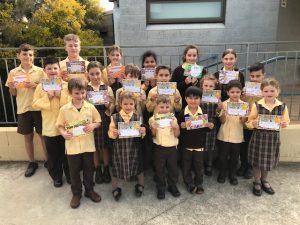Around the School
District Cross Country
Congratulations to all the students who represented St Augustine’s at the District Cross Country last week. Well done to the following students will now move on to the Division Cross Country at Brimbank Park!
Under 10 Boys: Ollie B 2nd, Tyson M 3rd, Marcus A 6th
Under 10 Girls: Ruby H 4th, Clara T 5th, Lara P 6th
Under 11 Girls: Bella C 2nd, Estelle S 3rd
Under 12 Boys: Cody M 1st, Maison C 6th,
Under 12 Girls: Jazelle B 1st, Trinity R 2nd
MATHS Education
On Friday 6th May, the staff had the opportunity to work with Dr James Russo from Monash University. James has a passion for Mathematics education, ensuring that it is enjoyable, engaging, student-centred and inclusive for all. The day focused on lesson structure and task design and how games and challenging tasks can provide deep mathematical understandings. In a world where our children are expected to be flexible and creative problem solvers, staff investigated how challenging tasks and rich mathematical discussions help students to form conceptual understanding of maths topics. James will be visiting our school again later in the term, this time spending time in some of our classrooms, modelling maths lessons and tasks to our teachers.
Maths at Home
If you are interested in increasing the use of Maths around your home, here is an article with some great ideas
Supporting numeracy at home
By Dr Simon Lindsay, General Manager, Improved Learning Outcomes and James Giannopoulos, Team Leader, Mathematics, Improved Learning Outcomes, at Melbourne Archdiocese Catholic Schools (MACS).
Is it harder to support children’s numeracy at home than it is literacy? National Assessment Program Literacy and Numeracy (NAPLAN) data from states where children spent longer periods in remote learning would seem to indicate that it is. The lockdowns due to the COVID-19 pandemic over the previous two years cast the role of the family in children’s learning into the spotlight, with many parents and carers anxious about the extent to which they could support their children’s learning, particularly in numeracy.
However, research shows that parents and carers can give their young children a boost in learning mathematics by noticing, exploring and talking about maths during everyday activities at home or out and about (Phillipson, Gervasoni & Sullivan 2017). This research further shows that parents play a key role in helping their children learn mathematics concepts involving time, shape, measurement and number. This mathematical knowledge developed before school is predictive of literacy and numeracy achievements in later grades.
The Let’s Count longitudinal evaluation findings, for example, show that when early years educators encourage parents and families to confidently notice, explore and talk about mathematics in everyday activities, their young children’s learning flourishes (Smith Family 2015).
What parents and carers can do to promote maths every day
Research also shows that one of the biggest barriers to parents and carers engaging in conversation about maths is their lack of confidence in leading maths education at home (Phillipson, Gervasoni & Sullivan 2017; Maloney et al. 2015). Through examining international research, the following types of activities were identified as important for early maths learning, which are easy for parents to use. These include:
- Comparing objects and describing wichis longer,shorter,heavier or holds less.
- Playing with and Describing Two-dimensional shapes and three-dimensional objects.
- Describing Where Things Repositioned,for example, north, outside, behind, opposite.
- Describing,copying,and extending patterns found in everyday situations.
- Using Time-words to describe points in time,events and routines(including days,months, seasons and celebrations).
- Comparing and talking about the duration of everyday events and sequence which they occur.
- Saying number names forward in sequence 10 (and eventually to 20 and beyond).
- Using Numbers To Describe And Compare Collections.
- Using Perceptual And Conceptual Subitising (recognising quantities based on visual patterns), counting and matching to compare the number of items in one collection with another.
- Showing Different Ways To Make A Tota l(at first with models and small numbers).
- Matching Number Names, symbols and quantities to 10’ (Phillipson,Gervasoni & Sullivan 2017).
Games to play using everyday situations
Neuroscience research has provided crucial evidence about the importance of early nurturing and support for learning, brain development, and the development of positive dispositions for learning (ZERO to THREE 2022).
There are plenty of everyday games and activities that can boost children’s mathematics learning. For example:
- talk with children as you prepare meals together
- talk about measuring and comparing ingredients and amounts
- look at maps, shapes and money
- play children’s card games and games involving dice, such as snakes and ladders.
Although these activities may seem simple and informal, they build on what children notice and question, give families the chance to talk about mathematical ideas and language, and show children that maths is used throughout the day.
Make it relevant to them
Perhaps most importantly, one of the best ways for children to get into maths is to by making it appealing and relevant to them. During everyday activities with children, such as walking down the street or sitting in the park:
- bring their attention to the objects around them that they are interested in – houses, cars, trees, signs
- guess the distance walked, in order to create a mental benchmark of metres and kilometres
- look at insects or small pebbles, highlighting millimetres or centimetres to encourage the need of using appropriate different metric units
- talk about the shapes and sizes of the objects, talk about and look for similarities and differences (for example, let’s find a taller tree or a heavier rock)
- count the number of cars parked in the street or time how long it takes to reach the next corner
- talk about the shapes within the objects, or the sizes of the objects
- talk about and look for similarities and differences (for example, let’s find a taller tree or a heavier rock)
- count the number of cars parked in the street or time how long it takes to reach the next corner
- discuss the temperature and how that feels
- discuss the speed of your walking pace
- explore sharing and dividing objects that are whole or in half to develop the understanding of equal groups and fairness.
It is never too soon to begin these activities. Babies who are only weeks old notice differences in shapes and the number of objects in their line of sight. So, from the earliest of ages, talk with your child about the world around them, being descriptive and using mathematical words. As they grow, build on what they notice about shapes, numbers and measures.
References
Henderson, A & Mapp, K (eds) 2002, A New Wave of Evidence: The Impact of School, Family, and Community Connections on Student Achievement, Southwest Educational Development Laboratory (SEDL), Texas, accessed 2 May 2022 https://sedl.org/connections/resources/evidence.pdf.
Maloney EA, Ramirez G, Gunderson EA, Levine SC, Beilock SL 2015, ‘Intergenerational Effects of Parents’ Math Anxiety on Children’s Math Achievement and Anxiety’, Psychological Science, 26 (9), 1480–1488.
Phillipson, S, Gervasoni, A & Sullivan P (eds) 2017, Engaging Families as Children’s First Mathematics Educators: International Perspectives, Springer, Singapore.
The Smith Family 2015, Strengthening early numeracy learning: The Let’s Count program, The Smith Family, Sydney, accessed 2 May 2022 www.thesmithfamily.com.au/- /media/files/research/reports/lets-count-research.pdf.
Award Winners
Congratulations to the following Award recipients for going above and beyond to make a difference and for displaying our STARR school values: Show respect, Teamwork, Always persist, Responsible, Resilient.







